Machine Learning for heat radiation modeling of bi-and polydisperse particle systems including walls
作者机构:Institute of Process and Particle EngineeringGraz University of TechnologyInffeldgasse 13/III8010GrazAustria
出 版 物:《Particuology》 (颗粒学报(英文版))
年 卷 期:2023年第74卷第3期
页 面:119-140页
核心收录:
学科分类:0710[理学-生物学] 0711[理学-系统科学] 08[工学] 0805[工学-材料科学与工程(可授工学、理学学位)] 080502[工学-材料学] 0701[理学-数学] 0812[工学-计算机科学与技术(可授工学、理学学位)]
主 题:Discrete element method(DEM) Heat radiation modeling Machine learning View factors Wall radiation Polydisperse particles
摘 要:We investigated the ability of four popular Machine Learning methods i.e.,Deep Neural Networks(DNNs),Random Forest-based regressors(RFRs),Extreme Gradient Boosting-based regressors(XGBs),and stacked ensembles of DNNs,to model the radiative heat transfer based on view factors in bi-and polydisperse particle beds including *** training and analyzing the predictive capability of each method,an adjustment of markers used in monodisperse systems,as well as an evaluation of new markers was *** the basis of our dataset that considers a wide range of particle radii ratios,system sizes,particle volume fractions,as well as different particle-species volume fractions,we found that(i)the addition of particle size information allows the transition from monodisperse to bi-and polydisperse beds,and(ii)the addition of particle volume fraction information as the fourth marker leads to very accurate *** terms of the overall performance,DNNs and RFRs should be preferred compared to the other two *** particle-particle view factors,DNN and RFR are on par,while for particle-wall the RFR is *** demonstrate that DNNs and RFRs can be built to meet or even exceed the prediction quality standards achieved in a monodisperse system.



